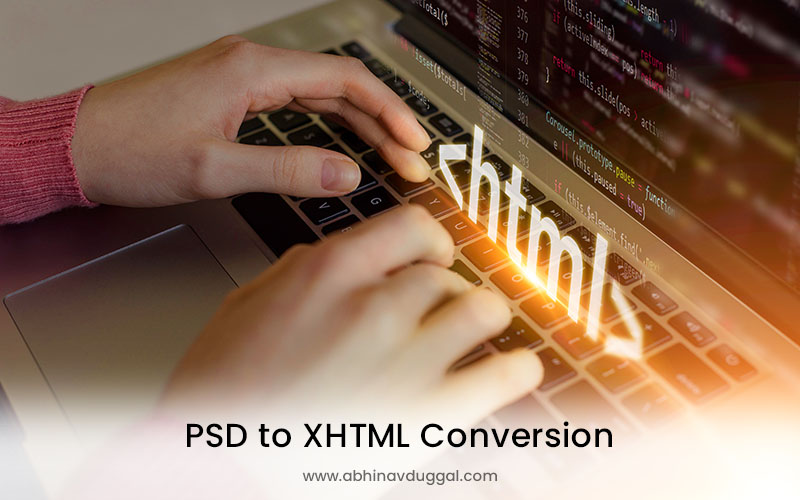PSD to XHTML Conversion

PSD to XHTML Conversion is the process of converting a Photoshop design file (PSD) into a clean, structured XHTML code that can be used for website development. This conversion helps businesses and designers turn static visual designs into interactive and functional websites. PSD to XHTML Conversion ensures cross-browser compatibility, faster loading, and adherence to web standards.
What is PSD to XHTML Conversion
PSD to XHTML Conversion involves slicing the PSD design into smaller parts and coding them into XHTML format using HTML, CSS, and sometimes JavaScript. XHTML stands for Extensible Hypertext Markup Language, which is a strict version of HTML designed to work well across different browsers and devices. This process ensures that the website looks exactly like the original PSD design and functions properly on all platforms.
Importance of PSD to XHTML Conversion
Converting PSD to XHTML is important because it provides a standard-compliant, flexible, and search-engine-friendly foundation for website development. XHTML code is cleaner and more reliable than plain HTML, ensuring better performance and easier integration with CMS platforms, APIs, and scripts. Businesses prefer PSD to XHTML Conversion to maintain design accuracy while building functional and professional websites.
Benefits of PSD to XHTML Conversion
Pixel-Perfect Conversion
Ensure the website matches the original PSD design accurately without losing quality.
Cross-Browser Compatibility
Websites work seamlessly on all modern browsers including Chrome, Firefox, Safari, and Edge.
SEO-Friendly Code
Clean XHTML code helps improve website ranking in search engines.
Faster Loading Speed
Optimized code and images ensure quick page loading and better user experience.
Easy Integration
Easily integrate XHTML with CMS platforms like WordPress, Joomla, or Magento.
Mobile-Friendly
XHTML code can be used to create responsive designs for smartphones and tablets.
Secure and Reliable
Standardized coding practices reduce errors and improve website stability.
Process of PSD to XHTML Conversion
1. Analysis of PSD Files
Review PSD designs to understand layout, colors, fonts, and structure.
2. Slicing the PSD
Cut the PSD into smaller sections to prepare for coding.
3. XHTML Coding
Convert the sliced images into XHTML with clean and valid code.
4. CSS Styling
Use CSS to style the XHTML elements according to the original design.
5. JavaScript Integration
Add interactive features like sliders, menus, and animations using JavaScript if needed.
6. Testing
Test the website for browser compatibility, responsiveness, and performance.
7. Deployment
Upload the final XHTML website to the server for public access.
Features of PSD to XHTML Conversion
W3C Compliant Code
Ensures adherence to web standards for better reliability and SEO.
Tableless Design
Modern XHTML websites use CSS for layouts instead of tables.
Semantic Markup
Structured code helps search engines understand website content.
Clean and Optimized Code
Reduces unnecessary tags and ensures faster page load.
High Resolution
Images retain quality while maintaining quick loading times.
Easy Maintenance
Clean code allows developers to update and modify websites easily.
Advantages of PSD to XHTML Conversion
Customizable Design
Turn unique PSD designs into fully functional websites.
Browser Compatibility
Ensure that the website looks consistent across all browsers.
SEO Ready
Semantic and clean code improves website ranking on search engines.
User-Friendly
Websites are easy to navigate and accessible on all devices.
Cost-Effective
Converting PSD to XHTML saves time and reduces development costs.
Scalable
Easily add new pages, features, or scripts as business grows.
Applications of PSD to XHTML Conversion
Corporate Websites
Professional websites for companies with custom designs.
E-Commerce Websites
Convert PSD designs into online stores with functional layouts.
Portfolio Websites
Showcase personal or professional work with creative designs.
Blogs and Magazines
Turn PSD layouts into interactive and responsive blog templates.
Event Websites
Create websites for conferences, exhibitions, or personal events.
Educational Portals
Design custom websites for schools, colleges, and online courses.
Tips for Effective PSD to XHTML Conversion
Plan Design Layout
Organize PSD files and website structure before conversion.
Optimize Images
Compress images without losing quality for faster loading.
Use Clean Code
Follow coding standards for XHTML, CSS, and JavaScript.
Test Responsiveness
Ensure the website works perfectly on all devices and screen sizes.
Integrate SEO Best Practices
Use proper headings, alt text, and meta tags for better visibility.
Use Reliable Tools
Leverage modern code editors and validation tools for accuracy.
Maintain Updates
Regularly check and update code for compatibility and security.
Tools for PSD to XHTML Conversion
Adobe Photoshop
Used for designing and managing PSD files.
HTML/XHTML Editors
Editors like Sublime Text, Visual Studio Code, or Dreamweaver for coding.
CSS
Used to style XHTML elements according to PSD design.
JavaScript
Add interactive features such as sliders, popups, or menus.
Validation Tools
W3C validators ensure code compliance with web standards.
CMS Integration
Converted XHTML code can be integrated with WordPress, Joomla, or Magento for dynamic websites.
Why Choose PSD to XHTML Conversion
Unique Design Implementation
Maintain the originality of your PSD design in the final website.
Reliable Performance
XHTML ensures fast loading and stable functionality.
SEO-Friendly Websites
Enhances search engine visibility with clean and structured code.
Mobile and Tablet Friendly
Responsive design ensures excellent user experience across devices.
Easy Maintenance and Updates
Clean code allows developers to manage and update content easily.
Cost-Effective Development
Reduces development time and effort while ensuring high quality.
Future of PSD to XHTML Conversion
PSD to XHTML Conversion will continue to be essential for businesses seeking pixel-perfect, standard-compliant, and SEO-friendly websites. Future trends include automation tools, AI-assisted slicing, and integration with modern CMS platforms. Businesses will increasingly demand responsive and interactive websites, making PSD to XHTML Conversion a reliable and professional solution for website development.
Conclusion
PSD to XHTML Conversion is a crucial step in turning creative designs into functional websites. It combines visual appeal with technical efficiency, ensuring cross-browser compatibility, responsiveness, and SEO readiness. Benefits include pixel-perfect design, clean code, faster loading, easy maintenance, and mobile compatibility. By following best practices and using reliable tools, businesses can get professional websites that accurately reflect their PSD designs and meet modern web standards. PSD to XHTML Conversion is ideal for corporate, e-commerce, blogs, portfolios, and educational websites, helping businesses achieve online success with a well-structured, visually appealing, and fully functional website.
Why Customers Loves Us?

15+ Years Of Experience In Digital Industry
With over a decade of hands-on experience, we’ve helped businesses across industries thrive in the digital space. Our expertise ensures strategic, results-driven solutions tailored to your unique goals.

Guaranteed Results

Skilled Professional

Excellent Customer Support

Powerful Tools

Confidential Agreement









